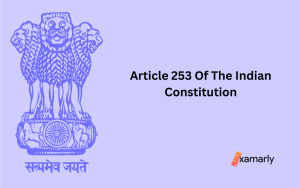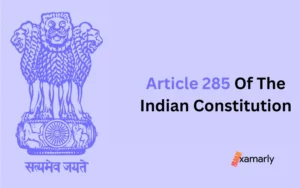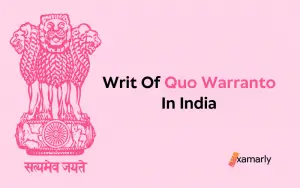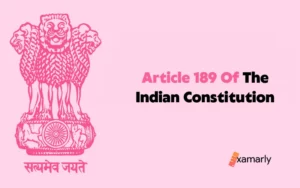Three different types of central government finances are mentioned in the Indian Constitution: the Consolidated Fund of India (Article 266), the Contingency Fund of India (Article 267), and the Public Accounts of India (Article 266).
The Contingency Fund is discussed under Article 267 of the Indian Constitution.
You’ll learn vital details about the said Article which is centered around the Contingency Fund of India from this page. This Article is useful for UPSC Exam preparation as it is a part of the Indian Polity of IAS Syllabus.
- What Is Article 267 Of The Indian Constitution?
- When Article 267 Was Approved?
- Contingency Fund of India
- Conclusion
- FAQs On Article 267
- What Article Of The Indian Constitution Establishes The Contingency Fund?
- Which Of The Indian Government's Funds Is The Most Significant?
- Is It Feasible For The States To Create A Separate Contingency Fund?
- What Is The India Contingency Fund?
- What Is Article 115 Of The Constitution Of India?
- What Is Article 116 Of The Constitution Of India?
- What Is Article 205 Of The Constitution Of India?
- What Is Article 206 Of The Constitution Of India?
What Is Article 267 Of The Indian Constitution?
The Contingency Fund is mentioned in Article 267 of the Indian Constitution. The Constitutional provisions of the aforesaid Article are mentioned in the following two clauses:
- Parliament may by legislation create a Contingency Fund in the form of an imprest, to be named “the Contingency Fund of India,” into which such sums as may be specified by such law shall be paid from time to time, and the said Fund shall be put at the disposal of the President to allow him to make advances out of such Fund for the aim of addressing unforeseen expenditure awaiting the permission of such expenditure by Parliament by law under article 115 or article 116.
- The Legislature of a State may by law form a contingency fund in the form of an imprest, to be called as “the contingency fund of the State,” into which shall be paid from time to time such amounts as may be set by such law. The said fund may be kept at the disposal of the governor of the state, allowing advances to be formed by him out of the such fund for the objectives of paying unforeseen expenditures awaiting the permission of such expenditure by the State Legislature by law under article 205 or article 206 of the Indian Constitution.
Relatable Articles:
When Article 267 Was Approved?
On 4 August 1949 and 13 October 1949, Draft article 248B (also known as Article 267) was considered. The 1948 Draft Constitution of India did not initially contain it. A Constituent Assembly member made the suggestion to include it.
The Draft Article gave the Union and State legislatures the authority to create a contingency fund to cover unforeseen expenses. The fund would be managed by the President or the Governor, depending on the situation.
The Member suggested including this Draft Article to give the Union and State executives the ability to cover unforeseen or unavoidable or urgent expenditures without legislative approval. He illustrated his point by referring to a comparable fund that existed in the United Kingdom.
Another member voiced their support for this Draft Article and expressed their belief that the financial provisions outlined in the Constitution would be lacking in the absence of a contingency fund. There was no more discussion after that. The 4 August 1949 saw the adoption of the Draft Article.
Contingency Fund of India
According to the Constitution, Parliament has the authority to establish the Contingency Fund of India into which periodically funds that have been duly constituted are paid. As a result, the India Contingency Fund Act was passed by Parliament in 1950.
The Contingency Fund of India, which is an imprest with a corpus of Rs. 500 crores, is authorized by Article 267 of the Constitution.
The President has access to this money and may use it to make advances to cover unforeseen costs while the Parliament considers it.
The President’s money is managed by the finance secretary. It is governed by executive order, just like India’s Public Account.
Every state is permitted to create its own contingency fund under clause 2 of Article 267 of the Constitution of India.
Conclusion
The Contingency Fund of India, as its name implies, serves as the country’s emergency fund. It is utilized when the country is experiencing a crisis, such as a natural disaster, and money is needed to deal with it.
FAQs On Article 267
What Article Of The Indian Constitution Establishes The Contingency Fund?
In accordance with Article 267 of the Indian Constitution, the contingency fund of India is established.
Which Of The Indian Government’s Funds Is The Most Significant?
The consolidated fund, which comprises all of the Indian government’s taxable and non-taxable receipts, is the most important of the three types of funds.
Is It Feasible For The States To Create A Separate Contingency Fund?
Yes. States may also decide to establish their own contingency funds.
What Is The India Contingency Fund?
The Contingency Fund of India is the country’s go-to financial safety net in the event of a national emergency. It is implemented if there is a national emergency, such as a natural disaster, or natural calamity, and funds are needed to address the situation.
What Is Article 115 Of The Constitution Of India?
Article 115 of the Constitution of India addresses supplementary, supplemental, and excess grants at the Union level.
What Is Article 116 Of The Constitution Of India?
Article 116 of the Indian Constitution addresses matters pertaining to votes on account, votes of credit, and exceptional grants at the Union level.
What Is Article 205 Of The Constitution Of India?
The Indian Constitution’s Article 205 addresses the topic of supplementary, supplemental, or excess grants at the State level.
What Is Article 206 Of The Constitution Of India?
Article 206 of the Indian Constitution talks about votes on account, votes of credit, and special grants at the State level.






